Agra travel - India, Asia
Agra, the city of the iconic Taj Mahal, is a historic gem in northern India, situated on the banks of the Yamuna River. This former capital of the Mughal Empire is renowned for its magnificent architectural marvels, approximately 206 kilometers south of New Delhi.
With it's rich cultural heritage, vibrant markets, and delectable cuisine, particularly the famous Mughlai dishes and sweets like petha, make it a must-visit destination for travelers seeking a glimpse into India's glorious past and a taste of its diverse flavors.
Population: Estimate 2,300,000 people (as of 2024)
Economy: Agra is a diverse economy that heavily relies on tourism, manufacturing, and agriculture. The city is a major tourist hub, attracting around 9.5 million visitors annually, primarily due to iconic landmarks like the Taj Mahal and Agra Fort, which significantly contribute to the local economy.
Approximately 40% of the population is engaged in agriculture, while the city is also renowned for its leather industry, producing over 150,000 pairs of shoes daily, making it one of the largest shoe manufacturing centers in India.
Landmarks: Taj Mahal, Agra Fort, Fatehpur Sikri, Itimad-ud-Daula's Tomb (Baby Taj), Jama Masjid, Chini Ka Rauza, Akbar's Tomb
India
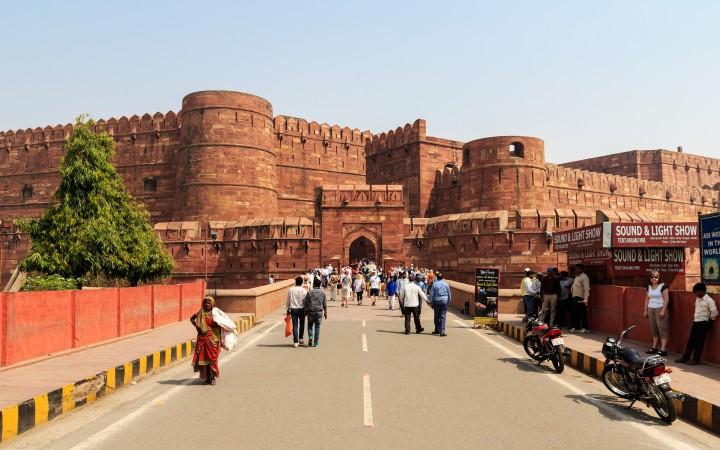
Overview of Agra
History & Cultural Influence
Agra's history is deeply intertwined with its significance as a major center of the Mughal Empire, which greatly influenced its cultural landscape. Founded in 1504 by Sultan Sikandar Lodi, Agra became prominent under Mughal rulers like Akbar, Jahangir, and Shah Jahan, who left a lasting legacy through architectural marvels such as the Taj Mahal and Agra Fort. These structures not only showcase exquisite Mughal architecture but also reflect the city's historical role as a cultural and political hub.
The cultural influence of Agra is evident in its vibrant arts and crafts scene, particularly in marble inlay work, leather goods, and textiles. The city's diverse population, comprising Hindus, Muslims, Jains, and others, contributes to a rich tapestry of traditions and festivals, including Taj Mahotsav, Diwali, and Urs Sufi Sahib.
Interaction with The Locals
With a diverse ethnic makeup that includes Hindus, Muslims, and other communities. When visiting Agra, you can expect a warm and welcoming interaction with the locals, who are known for their hospitality.
The city's population is predominantly Hindi-speaking, with a significant number of Urdu speakers as well. Locals are generally friendly and eager to assist tourists, often going out of their way to help with directions or recommendations. However, it's important to be aware of potential language barriers, as English proficiency may vary.
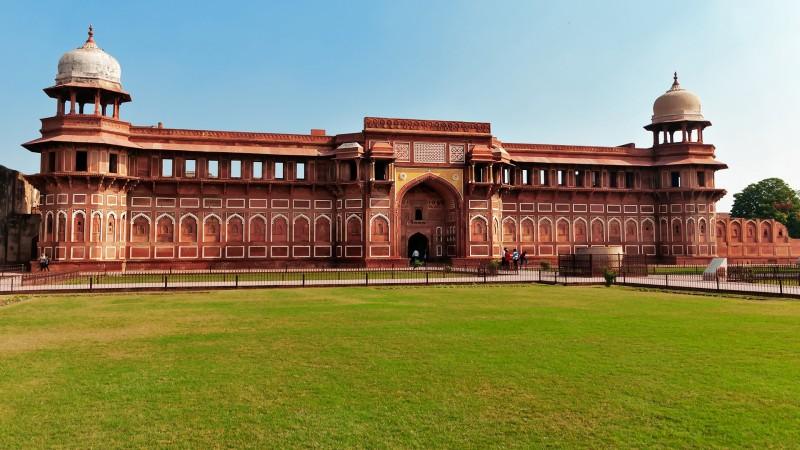
Agra Fort - © gather
Top attractions in Agra
Agra, a city steeped in history and architectural splendor, is home to some of India's most iconic landmarks. The Taj Mahal, a symbol of eternal love, mesmerizes with its stunning white marble beauty, while the grand Agra Fort offers a glimpse into the opulent lifestyle of the Mughal emperors. Just a short drive away, Fatehpur Sikri transports you back to the 16th century with its impressive red sandstone structures and the visionary legacy of Emperor Akbar.
Taj Mahal
Location: Taj Ganj, Agra, Uttar Pradesh
The Taj Mahal, an iconic symbol of love, was built by Mughal Emperor Shah Jahan in memory of his wife Mumtaz Mahal. Constructed between 1632 and 1648, this UNESCO World Heritage Site captivates with its stunning white marble architecture and intricate inlay work, making it an unforgettable experience for all who visit.
Agra Fort
Location: Agra Fort, Rakabganj, Agra, Uttar Pradesh
Agra Fort, a massive red sandstone fortress, served as the primary residence of the Mughal emperors before the capital was shifted to Delhi. Built by Emperor Akbar in the 16th century, this impressive fort showcases a blend of Islamic and Hindu architectural styles, with highlights like the Khas Mahal and Diwan-i-Khas that offer a glimpse into the grandeur of the Mughal era.
Fatehpur Sikri
Location: Fatehpur Sikri, about 40 km from Agra
Fatehpur Sikri, a UNESCO World Heritage Site, was the former capital of the Mughal Empire, built by Emperor Akbar in the late 16th century. This stunning city is known for its architectural marvels, including the grand Buland Darwaza and the magnificent Jama Masjid, offering you a journey back in time to explore Akbar's vision of a harmonious society.
Itimad-ud-Daula's Tomb (Baby Taj)
Location: Moti Bagh, Agra, Uttar Pradesh
Often referred to as the "Baby Taj," Itimad-ud-Daula's Tomb is the mausoleum of Mirza Ghiyas Beg, the grandfather of Mumtaz Mahal. Built between 1622 and 1628, this exquisite tomb is adorned with intricate marble inlay work and is considered a precursor to the Taj Mahal, offering a serene and artistic experience.
Mehtab Bagh
Location: Mehtab Bagh, opposite the Taj Mahal
Mehtab Bagh, known as the "Moonlight Garden," is a tranquil garden complex located directly opposite the Taj Mahal on the Yamuna River. This spot offers stunning views of the Taj, especially at sunset, making it a perfect location for photography and relaxation amidst lush greenery.
Chini Ka Rauza
Location: Near Agra, Uttar Pradesh
Chini Ka Rauza is a hidden gem, a mausoleum dedicated to Afzal Khan, a Persian poet and prime minister during Shah Jahan's reign. Built in the 17th century, it is famous for its distinctive blue and white glazed tiles, showcasing Persian architectural influences, and offers a unique cultural experience for those interested in Agra's lesser-known treasures.
Jama Masjid
Location: Jama Masjid, Agra, Uttar Pradesh
Jama Masjid, one of the largest mosques in India, was commissioned by Shah Jahan in 1648. The mosque is a marvel of red sandstone and white marble architecture, featuring a vast courtyard that can accommodate thousands of worshippers. Visiting this significant religious site offers a profound connection to Agra's spiritual and historical heritage.
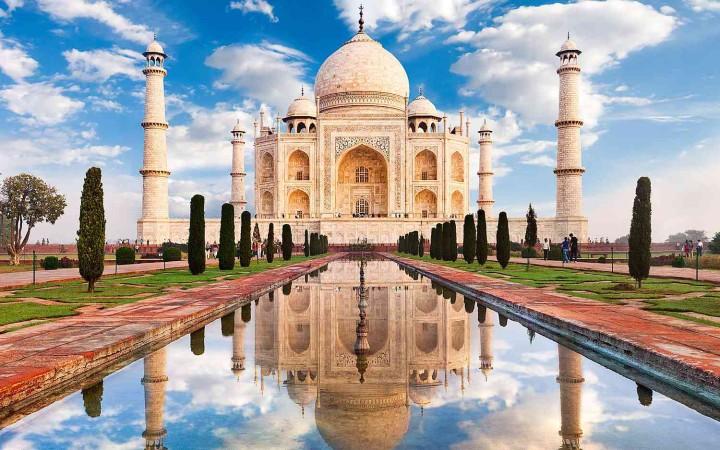
Taj Mahal - © gather
Must-Try Dishes in Agra
When in Agra, indulging in the city's culinary delights is a must. Start with Petha, a unique sweet made from ash gourd that comes in a variety of flavors, ranging from classic to saffron-infused. Another local favorite is Bedai, a spicy, puffed bread served with a flavorful potato curry, often enjoyed as a hearty breakfast by locals. These dishes offer a delicious glimpse into the traditional flavors of Agra.
Mughlai Biryani
A fragrant rice dish cooked with marinated meat, usually chicken or mutton, Mughlai Biryani is infused with saffron and a blend of aromatic spices. This dish is a staple in Agra, reflecting the city's rich Mughal heritage, and is often served during special occasions, making it a must-try for any culinary explorer.
Petha
Unique to Agra, Petha is a translucent candy made from ash gourd, often flavored with cardamom or saffron. This sweet delicacy has become a popular souvenir, symbolizing Agra's culinary identity, and is a delightful treat for those with a sweet tooth.
Agra Ka Dalmoth
Dalmoth is a savory snack made from a mix of lentils, nuts, and spices, known for its crunchy texture and spicy flavor. A popular street food in Agra, it's often enjoyed as a tea-time snack, making it a favorite among both locals and visitors looking for a taste of authentic Agra.
Tandoori Chicken
Tandoori Chicken, marinated in yogurt and spices, is cooked to perfection in a traditional clay oven, or tandoor. This popular dish offers tender and flavorful meat, often served with mint chutney and onion salad, and is a must-try for those seeking a true taste of Agra's culinary delights.
Kebabs
Agra is renowned for its variety of kebabs, including Seekh Kebabs and Galouti Kebabs, made from minced meat and a blend of spices. These dishes showcase the Mughal influence on local cuisine and are a must-try for meat lovers exploring the flavors of Agra.
Chaat
Chaat in Agra is a flavorful street food experience, offering a variety of savory snacks like Aloo Tikki Chaat and Dahi Puri. Made with potatoes, chickpeas, and tangy chutneys, these dishes provide a burst of flavors and textures that are sure to delight anyone looking to dive into the city's vibrant street food scene.
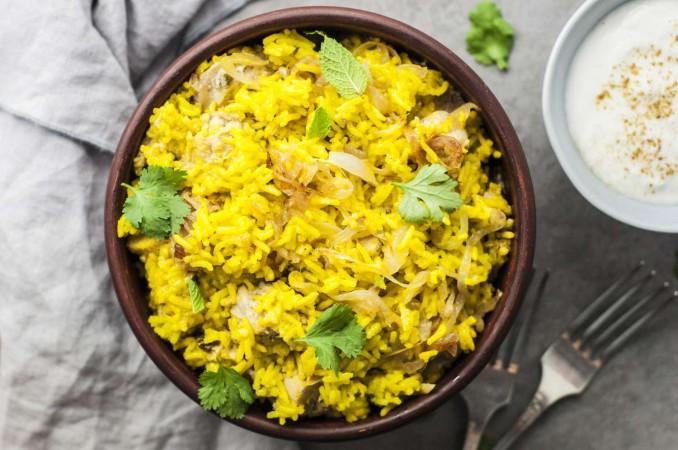
Mughlai Biryani - © gather
Festivals & Local Celebrations
Taj Mahotsav
Time of Year: February (10-day festival)
Taj Mahotsav is a lively annual festival held near the iconic Taj Mahal, celebrating Agra's rich cultural heritage. You can immerse yourself in a grand procession with decorated elephants and camels, explore stalls brimming with local crafts, and enjoy traditional music, dance performances, and mouthwatering regional cuisine. This vibrant festival offers a perfect opportunity to experience the artistic talents and traditions of Agra.
Ram Barat
Time of Year: September/October (before Dussehra)
Ram Barat is a unique and colorful procession that reenacts the marriage of Lord Rama and Sita, forming a key part of the larger Ramleela celebrations. You’ll witness a parade filled with beautifully decorated floats, traditional music, and performances by local artists, as the procession winds through the streets of Agra, creating an atmosphere of devotion, festivity, and celebration.
Bateshwar Fair
Time of Year: October/November (month-long festival)
Held in the nearby town of Bateshwar, this vibrant fair is dedicated to Lord Shiva and draws thousands of devotees. The fair offers a lively mix of religious rituals, cultural performances, and a bustling livestock market. As you explore the stalls selling local handicrafts and foods, you'll get a fascinating glimpse into the spiritual and cultural life of the region.
Kailash Fair
Time of Year: August/September
Kailash Fair takes place at the Kailash temple, about 12 km from Agra, celebrating the appearance of Lord Shiva as a stone lingam. This spiritual gathering is filled with rituals, music, and local festivities, where you can join devotees in paying homage to the deity and soak in the vibrant, devotional atmosphere.
Holi
Time of Year: March (spring festival)
Holi, the joyous festival of colors, is celebrated with exuberance in Agra. You’re invited to join the fun, throwing vibrant colored powders, singing, dancing, and indulging in traditional sweets. The celebrations often extend to nearby towns like Vrindavan and Mathura, famous for their spirited Holi festivities, making it a truly unforgettable experience.
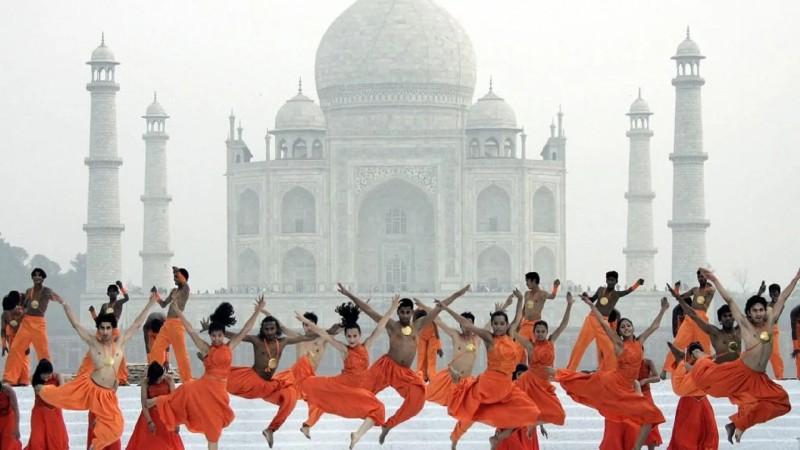
Taj Mahotsav - © gather
Weather in Agra: Best Time to Visit
Agra experiences a semi-arid climate, characterized by hot summers, mild winters, and a monsoon season.
Average Temperatures
- Summer (March to June): Daytime temperatures can soar above 40°C, often reaching up to 46°C in May. Nights are relatively cooler, averaging around 30°C.
- Monsoon (July to September): This season brings significant rainfall, averaging about 628.6 mm, with temperatures ranging from 25°C to 35°C.
- Winter (December to February): Winter temperatures can drop to as low as 3°C, with January being the coldest month, averaging around 15°C.
Rainfall
Annual Rainfall: Approximately 760 mm, with the heaviest rains occurring in July and August.
Best Time to Travel
The ideal time to visit Agra is from mid-November to mid-February, when the weather is cooler and more pleasant for sightseeing. However, visitors should be prepared for potential fog and pollution during this period.
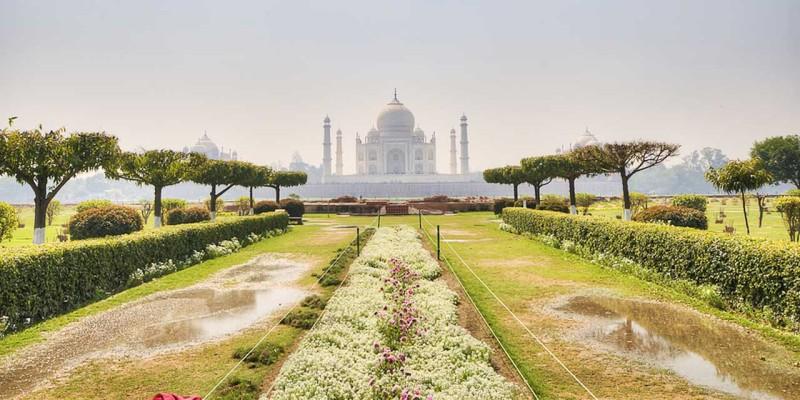
Mehtab Bagh - © agratourism
Culture Etiquette in Agra
Dress Modestly
Both men and women should dress modestly, especially when visiting religious sites. Cover shoulders and knees. Light, breathable fabrics are recommended due to the hot climate.
Greetings
Greet locals with a friendly "Namaste" and a slight bow. This gesture is a sign of respect.
Dining Etiquette
- Eat with your right hand only, as the left hand is considered unclean. Avoid using your left hand to pass food or touch dishes.
- Eating with family or friends is often communal. Sharing food is a sign of hospitality.
Respect Religious Practices
- Remove shoes when entering temples and mosques. In some cases, cover your head as well.
- Avoid wearing leather products and touching holy books or idols with your feet, as this is considered disrespectful.
Photography
- Ask for permission before taking photos of locals, especially women. Some may not feel comfortable being photographed.
- Avoid taking photos of military or government buildings, as it may be prohibited.
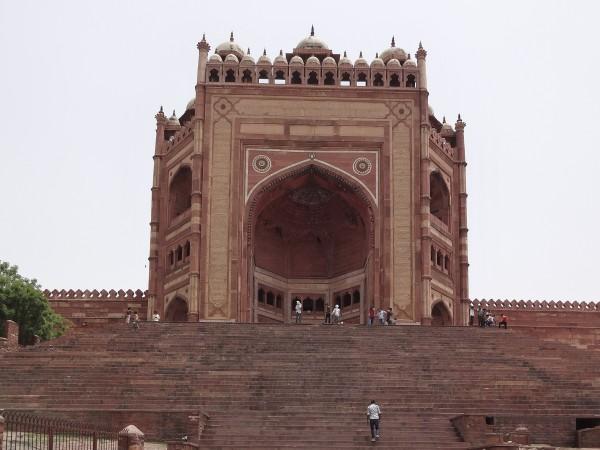
Buland Darwaza - © gather
Essential Travel Information
Getting to Agra
Air
Agra Airport (Kheria Airport): Currently, Indigo operates flights connecting Agra to major cities like Mumbai, Ahmedabad, Bhopal, and Bangalore. The airport is controlled by the Indian Air Force and is about 12 km from the city center.
Rail
Rail Connectivity: Agra is served by several railway stations, with Agra Cantonment being the major station on the Delhi-Mumbai line. Other stations include Agra Fort, Raja-Ki-Mandi, and Idgah. The city is well-connected by express trains, including the Gatiman Express, which offers a fast service from Delhi, reducing travel time to about 100 minutes.
Road
Bus Services: Agra has multiple bus stands, including the Inter-State Bus Terminal (ISBT) and Idgah Bus Stand, connecting it to various cities in northern India. The city is a junction for several national highways, including NH 19 and the Yamuna Expressway, making it easily accessible by car.
Getting Around Agra
Taxis and Auto Rickshaws
- Taxis: Renting a taxi for a full day is a popular option for tourists, with costs around USD 50 for over 12 hours. Taxis can be booked through hotels or local taxi services.
- Auto Rickshaws: These are widely available and are a convenient way to navigate the city. They are often used for short distances and can be hired for a quick trip to local attractions.
Public Transit
City Buses: Although available, city buses are infrequent and may not be the most reliable option for tourists.
Eco-Friendly Transport
Battery-Operated Vehicles: Due to restrictions on polluting vehicles near the Taj Mahal, visitors can use battery-operated autos or horse-drawn carriages (tonga) to reach the monument from nearby parking areas.
Metro
Agra Metro Project: A metro rail project is underway, which will include multiple stations and improve urban transport in the city once completed.
ATM and Banking Services
Agra offers several ATMs and banking facilities for easy access to cash and financial services:
HDFC Bank ATM
Location: No 1 to 3, Shanti City Center, Bhagrathi Devi Marg, Taj Nagari, Khandari, Agra, Uttar Pradesh
Phone: +91 94267 92009
Hours: Open 24 hours
State Bank of India ATM
Location: Police Lines Rd, Rakabganj, Agra, Uttar Pradesh
Phone: +91 1800 11 2211
Hours: Open 24 hours
Bank of Baroda ATM
Location: 8/181 A Kaushal Pur, Bypass Rd, Nagla Padi, Agra, Uttar Pradesh
Phone: +91 1800 5700
Hours: Open 12 PM – 12 AM daily
These ATMs provide convenient access to cash for travelers, ensuring that banking services are readily available.
Accommodation Choices
Agra offers a range of accommodation options, from budget stays to more comfortable lodging:
Luxury Hotels
- The Oberoi Amarvilas: Known for its stunning views of the Taj Mahal, this luxury hotel offers opulent rooms and exceptional service.
- ITC Mughal: A five-star hotel that combines Mughal architecture with modern amenities, providing a luxurious stay.
Mid-Range Hotels
- Hotel Taj Resorts: Located near the Taj Mahal, this hotel offers comfortable rooms and a rooftop pool, making it a popular choice for tourists.
- Hotel Clarks Shiraz: A well-known hotel offering a blend of comfort and convenience, with easy access to major attractions.
Budget Hotels and Guesthouses
There are numerous budget hotels and guesthouses that provide basic amenities and a chance to experience local hospitality. These often include family-run establishments that offer a more personalized experience.
Articles for you

Experience Aboard The RV Indochine II - A Mekong Cruise With Tweet World Travel
The RV Indochine II is a luxury river cruise ship, offering an unforgettable journey through many attractions along the Mekong River. Built in 2017, this upscale vessel combines colonial elegance with modern conveniences to create a comfortable yet stylish environment for its crew and passengers. The ship’s intimate size makes it ideal for those seeking a more personal cruising experience while exploring Vietnam and Cambodia rich culture, scenery, and heritage. Whether you're gazing at the landscape from your private balcony or enjoying authentic local cuisine, RV Indochine II promises an exotic adventure like no other.

Witness Stilt Fishing In Sri Lanka: An Eco-Tourism Experience
Sri Lanka, renowned for its stunning beaches and rich cultural heritage, harbors a unique tradition that has captivated travelers for centuries: stilt fishing. This ancient practice, passed down through generations of coastal communities, blends artistry with necessity, offering a glimpse into a way of life intimately connected to the island's coastal rhythms. Stilt fishing in Sri Lanka isn't merely a means to catch fish; it's a cultural emblem, embodying the resilience and ingenuity of Sri Lanka's fishing communities.

Make Your Trip Stress-Free With The Tweet Trip App
Embark on your next adventure with confidence by downloading the Tweet Trip App, available for both iOS and Android. This essential travel companion allows you to view your detailed itinerary, stay connected with your tour guide and fellow travelers, receive real-time updates, and provide feedback effortlessly. With features like in-app messaging, emergency assistance, and location sharing, the Tweet Trip App ensures you travel smarter, stay connected, and enjoy a seamless, worry-free journey. Get started today and make the most of your travel experience with Tweet World Travel.

Pedal Through Paradise: Unveiling Cambodia's Hidden Gems on Two Wheels
The gentle whir of bicycle wheels mingles with the distant chants of monks as you glide past emerald rice paddies stretching to the horizon. This is Cambodia - a sensory explosion waiting to be experienced on two wheels. At Tweet Tours, we believe there's no better way to immerse yourself in the Kingdom of Wonder than by bicycle.
Cambodia isn't just a destination; it's a living, breathing tapestry of ancient wonders, natural beauty, and vibrant culture. Our carefully crafted cycling tours take you beyond the typical tourist haunts, offering a unique perspective on this captivating country. Ready to clip in and discover the magic of Cambodia? Let's ride!

Trekking in the Himalayas: A Journey Through Nepal's Majestic Peaks
The Himalayas rise from the earth like colossal guardians, their snow-capped peaks piercing the sky in a display of nature's raw power and beauty. Nepal, nestled at the heart of this mountain range, serves as the gateway to some of the most breathtaking trekking experiences on the planet. Here, the air is crisp and thin, filled with the promise of adventure and the whispers of ancient tales.
With Tweet Tours, as you set foot on these hallowed trails, you're not just a traveler - you're a modern-day explorer, following in the footsteps of legendary mountaineers and age-old traders. Each step takes you further into a world where nature reigns supreme and human resilience is tested against the backdrop of some of the world's highest peaks.
From the moment your boots touch the ground in Kathmandu, you'll feel the pull of the mountains. The bustling streets of the capital, with their sensory overload of sights, sounds, and smells, soon give way to serene mountain paths where the only soundtrack is the crunch of gravel underfoot and the distant tinkling of yak bells.

Exploring Mui Ne's Wonders: Unique Attractions & Local Dishes
Nestled along the southeastern coast of Vietnam, Mui Ne emerges as a captivating gem, blending natural wonders with cultural richness. Renowned for its stunning landscapes and unique attractions, Mui Ne beckons travelers seeking both relaxation and adventure in equal measure. Mui Ne's renowned beach dunes, bustling fishing towns, and excellent local food await exploration at every turn.
The allure of Mui Ne lies not only in its pristine beaches and crystal-clear waters but also in its diverse range of activities catering to every traveler's whims. Whether you're drawn to thrilling water sports like kitesurfing and windsurfing on its dynamic shores or seeking tranquility amidst the picturesque Fairy Stream, Mui Ne promises an unforgettable journey filled with discovery.
